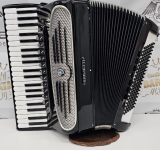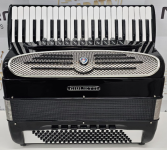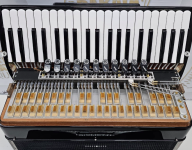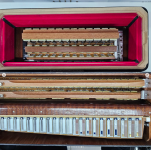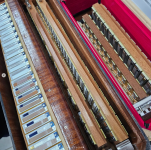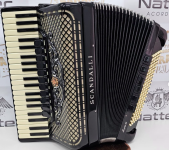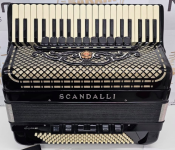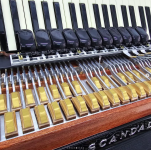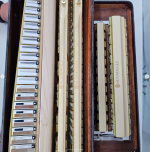Good evening everyone. I'm currently thinking about acquiring a new accordion. My current one is an Excelsior Mod. 2000 E R, which apparently is kind of a "rare" model (not many were made before Pigini bought CEMEX, and production stopped then). I made a post about it back when I bought it (thank very much to everyone who replied back then, btw  ). I like the Excelsior a lot, but it has some little details that need fixing. I was wondering if it'd be more cost effective to fix them or use the money to buy a new one. I'm researching these details but, in the meantime, I thought it'd be best to already research a possible new accordion.
). I like the Excelsior a lot, but it has some little details that need fixing. I was wondering if it'd be more cost effective to fix them or use the money to buy a new one. I'm researching these details but, in the meantime, I thought it'd be best to already research a possible new accordion.
I'm in Brazil. Importing is actual hell because of customs, so I'm looking at the models available in the Brazilian market. The current two models that caught my attention are the ones in the post's title (pictures attached). Both accordions are new an were made somewhat recently. As far as I'm concerned:
1) Scandalli is still an independent factory. I tested it and, to no one's surprise, Super VI Extreme is a great accordion (apparently, it's one of the best Stradella model made by Scandalli nowadays). Unfortunately, I've no details about the quality of the materials and the built quality of the instrument. Although the bass decoupler is a nice feature, but it's not a selling point for me (maybe one day I'd love it, but this is very unlikely). It's the most expensive alternative.
2) Giulietti's status confuses me (the history of accordion manufacturers is insanely convoluted for some ungodly reason). As far as I know, the factory doesn't exists anymore and the new Classic 127 accordions are made by Bugari Armando (I've seen some people mentioning it on the forum, so I assume that this is indeed the case). I've tested it and it sounds great (specially the bass, very low and deep), it truly feels like a great accordion. However, as is the case with the Extreme, I've no details on the quality of the materials and the built quality of the instrument. The Classic's reed blocks' wood is darker than the Extreme (no idea if this matters though). It's the most affordable alternative.
As you guys can see, I've little information regarding the accordions at hand. Sound wise, they're different, but I like both. Therefore, the main selling point for me is quality. I'd like a sturdy, resilient, well-built accordion made with quality materials that will last. If the leap isn't too huge, I reckon the Giulietti is the better option (it's price tag is 73% of the Extreme after all). However, if the Extreme is way superior, I'm willing to go an extra mile and get it.
My idea with this post is to (hopefully) find people that know the technical details that I'm missing and can help me better understand these accordions, so that I can choose correctly. Of course, it'd be nice to know if buying a new one is a good idea is a better idea than "improving" (i.e., sending to a professional to make all the necessary repairs and adjustments) an Excelsior fabricated in the 90's. In advance, I'm truly thankful to everyone who can help
I reckon that the following info is the most relevant:
1) Type and quality of the reeds. I know that the Extreme's reeds are a mano reeds and are the best ones currently offered by Scandalli. I've no idea about the Classic's reeds, though. Do they use a mano reeds as well? Or they use, for example, Binci reeds for the Classic 127?
2) Type and quality of wood. I don't know if it can be infered from the pictures, or if this info is available somewhere. It'd be amazing to know though, for this plays a huge role on the lifespan and sound quality of the insrument.
3) Quality of built. I reckon that Scandalli and Bugari are some of the best when it comes to this, but it's always good to see if one has an upper hand over the other for some reason.
I'm in Brazil. Importing is actual hell because of customs, so I'm looking at the models available in the Brazilian market. The current two models that caught my attention are the ones in the post's title (pictures attached). Both accordions are new an were made somewhat recently. As far as I'm concerned:
1) Scandalli is still an independent factory. I tested it and, to no one's surprise, Super VI Extreme is a great accordion (apparently, it's one of the best Stradella model made by Scandalli nowadays). Unfortunately, I've no details about the quality of the materials and the built quality of the instrument. Although the bass decoupler is a nice feature, but it's not a selling point for me (maybe one day I'd love it, but this is very unlikely). It's the most expensive alternative.
2) Giulietti's status confuses me (the history of accordion manufacturers is insanely convoluted for some ungodly reason). As far as I know, the factory doesn't exists anymore and the new Classic 127 accordions are made by Bugari Armando (I've seen some people mentioning it on the forum, so I assume that this is indeed the case). I've tested it and it sounds great (specially the bass, very low and deep), it truly feels like a great accordion. However, as is the case with the Extreme, I've no details on the quality of the materials and the built quality of the instrument. The Classic's reed blocks' wood is darker than the Extreme (no idea if this matters though). It's the most affordable alternative.
As you guys can see, I've little information regarding the accordions at hand. Sound wise, they're different, but I like both. Therefore, the main selling point for me is quality. I'd like a sturdy, resilient, well-built accordion made with quality materials that will last. If the leap isn't too huge, I reckon the Giulietti is the better option (it's price tag is 73% of the Extreme after all). However, if the Extreme is way superior, I'm willing to go an extra mile and get it.
My idea with this post is to (hopefully) find people that know the technical details that I'm missing and can help me better understand these accordions, so that I can choose correctly. Of course, it'd be nice to know if buying a new one is a good idea is a better idea than "improving" (i.e., sending to a professional to make all the necessary repairs and adjustments) an Excelsior fabricated in the 90's. In advance, I'm truly thankful to everyone who can help
I reckon that the following info is the most relevant:
1) Type and quality of the reeds. I know that the Extreme's reeds are a mano reeds and are the best ones currently offered by Scandalli. I've no idea about the Classic's reeds, though. Do they use a mano reeds as well? Or they use, for example, Binci reeds for the Classic 127?
2) Type and quality of wood. I don't know if it can be infered from the pictures, or if this info is available somewhere. It'd be amazing to know though, for this plays a huge role on the lifespan and sound quality of the insrument.
3) Quality of built. I reckon that Scandalli and Bugari are some of the best when it comes to this, but it's always good to see if one has an upper hand over the other for some reason.
Attachments
Last edited:

